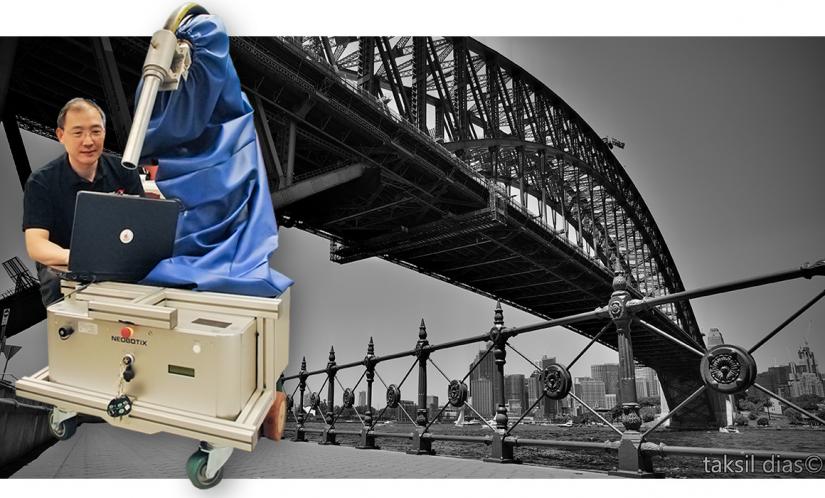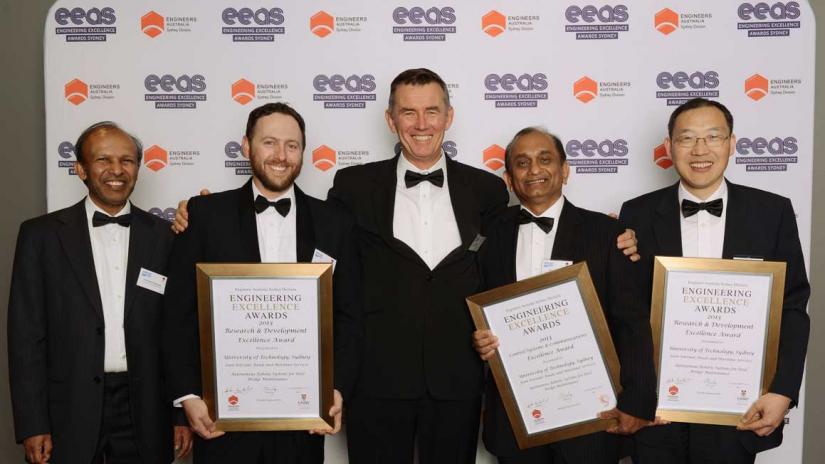Inside the southern spans of the Sydney Harbour Bridge, NSW Roads and Maritime Services (RMS) has embarked on Australia’s largest bridge maintenance program: grit-blasting away old paint and corrosion. It’s dangerous work, potentially exposing workers to lead paint and fine dust.
But autonomous robots Rosie and Sandy have come to the bridge cleaners’ aid. Developed by a UTS and RMS joint research team, these 25kg ‘smart’ machines are the first of their kind in the world.
The job is very risky – the bridge vibrates because of the traffic and it has a complex geography – which is why we approached UTS to see if a machine could do this kind of work.
— Waruna Kaluarachchi, Planning and Delivery Manager, NSW Roads and Maritime Services
For director of UTS’s Centre for Autonomous Systems, Professor Dikai Liu and his team, the brief was to design robots with a number of key capabilities: “We needed a really light-weight robot but one that also had a high payload (the force used to blast away paint) and that could work on its own in an unfamiliar environment,” says Liu. “Such a thing didn’t exist.”
So from 2006, Liu and his team collaborated with NSW RMS to develop their first intelligent robot prototypes and test them on the Harbour Bridge.
Sandy and Rosie operate using sensors and cameras to navigate unfamiliar terrain and create a 3D map of the area. They then calculate where and how to position their grit-blasting nozzles for optimum cleaning.
On the robots’ instruction, human operator presses the ‘blast’ button and the robots start methodically stripping paint from the steelwork.
Abrasive blasting is big business – representing a $1.2bn global market. In the US, Europe and Japan alone, there are 270,000 steel bridges, all of which have the potential to benefit from this UTS-developed technology.
With investment from Sydney-based abrasive blasting equipment company, Burwell, the researchers have commercialised the technology, forming spin-off company Sabre Autonomous Solutions. They are now refining the robots’ unique capabilities for the broader abrasive blasting industry in Australia and overseas.
We have a world-first robotic solution – one that operates autonomously even in awkward and complex steel bridge maintenance environments. This robotic technology can be adapted to many other industries including steel fabrication, construction and cleaning.
— Professor Dikai Liu, Director, Centre for Autonomous Systems
Awards and recognition
- winner of two Engineering Excellence Awards Sydney Division in the Control Systems and Communications, and Research and Development categories
- finalist in the Engineers Australia National awards
- finalist in the Australia Museum Eureka awards – ANSTO Eureka Prize for Innovative Use of Technology
- finalist in the prestigious international Innovation and Entrepreneurship in Robotics and Automation award, organised by the International Federation of Robotics and Institution of Electrical and Electronic Engineers USA (IEEE)
Research team
-
Director, UTS Robotics and Distinguished Professor, School of Mechanical and Mechatronic Engineering
Faculty/research centre
Funded by
- NSW Roads and Maritime Services
- Australian Research Council Linkage grant
- Sabre Autonomous Solutions



